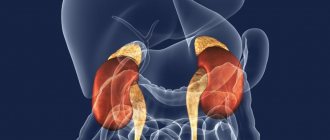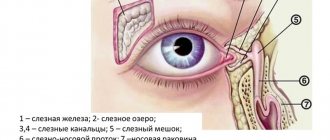The adrenal glands are endocrine glands that produce large amounts of endocrine hormones and thereby regulate many human life processes. In turn, diseases of the adrenal glands entail significant pathological changes in the body.
Each adrenal gland, a paired organ located at the upper pole of the kidney, consists of a cortex and a medulla. The cortex produces mineralocorticoids (responsible for the exchange of water and minerals in the body), glucocorticoids (metabolism and energy), and sex hormones. The medulla produces adrenaline and norepinephrine. Depending on where the pathological process arose, a corresponding picture of the disease appears.
How does oncology develop?
Cancer begins with the appearance in the body of just one altered cell, which is formed due to hereditary characteristics or various diseases, multiplies and creates a tumor. Most of these cells detect and destroy the immune system, but some of them manage to hide from the attention of our natural defenses or resist it. They enter the circulatory or lymphatic system. The lymphatic system complements the cardiovascular system. The lymph circulating in it - the intercellular fluid - washes all the cells of the body and delivers the necessary substances to them, taking away waste. Lymph nodes located throughout its network, acting as “filters,” identify and neutralize dangerous substances. systems., with their help they spread throughout the body, become established in other tissues and create metastases - additional foci of the disease.
What is the adrenal gland, why do we need it and how does oncology develop in it?
Each adrenal gland consists of two structures.
Outside the organ is the cortical layer
, in which most tumors arise. It produces important hormones:
- Cortisol
– helps the body cope with stress. - Aldosterone
– regulates blood pressure and the amount of salt in the blood. - Androgens
, which can be converted to other forms of hormones: - estrogens necessary for the proper functioning of the ovaries, uterus, vagina and mammary glands,
- as well as testosterone, which is involved in the production of sperm, affects the development of bone and muscle tissue in men.
In its inner part there is a medulla
, which is a continuation of the nervous system. It produces adrenaline, which helps us quickly respond to stress and extreme situations. When it is released, the pulse quickens, blood flow in the body is redistributed, minor vessels narrow, and important ones supplying the brain and heart expand. Dangerous neoplasms also arise in this area of the organ – neuroblastomas, which develop from nerve cells.
Doctors distinguish 2 types of adrenal cortex tumors:
- Adenomas
: benign, which means they do not grow into surrounding tissues and do not spread throughout the body. As a rule, their size does not exceed 5 centimeters in diameter, and most of their owners do not have any symptoms and are not aware of their disease. Some are discovered by chance during testing for other health problems. - Carcinomas
are cancers, which we will discuss in detail in this text.
The structure of the adrenal glands
The second name of the paired organ is the adrenal glands. They are located in the lumbar region and have the shape of “caps” on the kidneys. Although the functions of these organs are the same, their shape is different. On the right side, the iron has the shape of a triangle, on the left - a crescent. Connective tissue protects the glands. Organ tissue consists of two layers. The outer one is the cortex, the inner one is the medulla. The adrenal glands do not have excretory pathways; hormones penetrate directly into the circulatory system.
A significant part of the adrenal glands is occupied by the cortex. The cells located here produce sex and corticosteroid hormones. The cortex consists of three sections, which differ from each other in the characteristics of their cells:
- Glomerular. In this part, the cells are united into “glomeruli”. They are responsible for the production of corticosterone, aldosterone, and deoxycorticosterone. They occupy about 15% of the outer layer of the adrenal glands. Monitor blood pressure levels and maintain normal water-salt balance.
- Beam. Most of the cortex is occupied by bundles of large cells. They produce glucocorticoids (cortisol and cortisone), which are necessary to maintain immunity. These hormones prevent the proliferation of connective tissues, reduce allergic reactions and prevent the intensive development of inflammation.
- Reticulate. Contains cells of various structures that form a network. In this area of the adrenal glands, DEASO4 is produced, as well as androstenedione. These hormones are responsible for secondary sexual characteristics and the pregnancy process.
The brain region contains chromaffin cells. The production of norepinephrine and adrenaline is necessary to regulate the body's reactions under stressful conditions.
Causes of adrenal cancer
Scientists and doctors do not know exactly why this type of cancer develops in the body of a particular person - they only know the factors that increase the likelihood of this event.
Genetics
Most cases of adrenal cancer are not hereditary, but up to 15% of them are caused by mutations, or changes in genes that contain information about the body's characteristics. These include:
- Li-Fraumeni syndrome
is a rare disease that increases the risk of several types of cancer, including breast, brain, and bone. - Beckvidet-Wiedemann syndrome
, resulting in disproportionate growth of the body and internal organs such as the liver, spleen, kidneys and tongue. - Familial adenomatous polyposis
, which causes the formation of hundreds of polyps - tissue growths in the intestines. - Multiple endocrine neoplasia
, which significantly increases the likelihood of tumors of three glands: pituitary gland The pituitary gland is a small gland located at the base of the brain that affects metabolism, body growth and reproductive function in men and women., parathyroid The parathyroid gland regulates the amount of calcium in the body. and pancreasThe pancreas produces substances necessary for digesting food and regulates blood sugar levels. - Lynch syndrome
is an inherited disease that increases the chances of developing colon, stomach and other cancers, including the adrenal glands.
Lifestyle
Excess weight, smoking, insufficient exercise and exposure to chemicals can cause many types of cancer. To date, the effect of these factors on the adrenal glands has not been proven, but part of the scientific community believes that tobacco smoke has a similar effect.
Signs and symptoms of adrenal cancer
As a rule, signs of the disease do not appear immediately - usually a person feels them only after the tumor grows to a fairly large size. In about half of patients, health problems arise due to hormones produced by cancer, and in another 50% they develop when it grows and compresses nearby organs.
In children, symptoms are most often caused by androgens. Androgens are involved in the production of sperm and also affect the development of bone and muscle tissue. – “male” hormones secreted by cancer. The most common of these are excessive hair growth on the face and body, for example in the pubic area and armpits. Under the influence of estrogens, which are necessary for the proper functioning of the ovaries, uterus, vagina and mammary glands, girls often begin early puberty, and boys have enlarged mammary glands.
In adults, the influence of these substances is less noticeable, since their body is already fully formed. It is for this reason that women with estrogen-producing cancer and men with androgen-producing tumors in the early stages do not show any signs of the disease.
Problems are easier to notice if the tumor produces a hormone that is normally present in the body in small quantities. In such cases, the representatives of the stronger sex have enlarged breasts, become painful, and problems appear in the intimate sphere - their sex drive decreases and erectile dysfunction occurs. In women, hair grows on the face and body, bald spots appear, the voice deepens, and menstrual cycles become irregular.
An increase in cortisol levels, which the body needs to cope with stress, leads to the development of a number of symptoms, such as:
- obesity;
- deposition of fatty tissue in the face, neck, chest, abdomen, as well as behind the neck and shoulders;
- rounding of the face;
- formation of striae - purple stretch marks on the abdomen;
- excessive hair growth on the face, chest and back in women;
- menstrual irregularities;
- weakness and loss of muscle mass in the legs;
- high blood pressure;
- the appearance of bruises and bruises even after minor exposure to the skin;
- depression, mood swings;
- osteoporosis - a decrease in calcium content and bone strength, and consequently their frequent fractures;
- high blood sugar levels, often leading to diabetes - the body's inability to transfer glucose from the blood to tissue cells to obtain the energy they need.
The main symptoms of producing too much aldosterone, which regulates the amount of salt in the blood, are high blood pressure, weakness, muscle cramps and low potassium levels.
As a tumor grows and increases in size, a person may experience pain in the areas closest to the tumor, a feeling of fullness in the abdomen, or problems with eating due to a constant feeling of fullness in the stomach.
ATTENTION PATIENTS!
Currently, the North-Western Endocrinology Center provides free surgical treatment for patients with adrenal tumors
. Treatment is carried out within the framework of the compulsory medical insurance program or the SMP program (specialized medical care).
To obtain free hospitalization for out-of-town patients
you must send copies of documents (passport: page with photo and basic data, page with registration; compulsory health insurance policy, SNILS, results of existing examinations - a detailed list is presented below) to the address
Questions about hospitalization can be asked to the responsible administrator, Valentina Petrovna Kleshnina, by calling +7 900 6291427 (weekdays, from 9 a.m. to 5 p.m.).
Package of necessary examinations
should include the following list (if there are no results from the listed studies, they must be performed in any case):
- CT or MRI of the abdominal cavity, if there is only an ultrasound report, then it is necessary to perform a CT scan of the abdominal cavity without contrast, indicating the native density of the adrenal tumor (if necessary, print this item and show the CT scan to the doctor before the study).
The following laboratory parameters must be determined:
- Aldosterone, renin, potassium in the blood, in case of taking diuretics, they must first be discontinued for three weeks (tests are taken in the morning from 8 to 9 am, sit for 15 minutes before taking the tests), after taking these blood tests, resume taking your previous medications;
- Analysis of 24-hour urine or blood for total metanephrines;
- Performing a test with 1 mg of Dexamethasone (in the evening, at 23:00, take 2 tablets of Dexamethasone, in the morning of the next day - from 8 to 9 in the morning, determining the level of cortisol in the blood), the analysis is taken separately from the others, in the last place.
You must also provide information
about the normal level of blood pressure in the patient (working blood pressure), if the pressure increases, indicate the maximum blood pressure numbers, how long ago the increase has occurred and how often rises in blood pressure occur.
To carry out the above examinations, there is no need to go to the hospital; they can be performed at your place of residence or in the nearest laboratory.
For patients from St. Petersburg
It is advisable to apply for a face-to-face consultation before entering the clinic (make an appointment by phone (812) 565-11-12, Primorsky branch of the center, address: Savushkina St., 124, building 1, make an appointment by phone (812) 498-1030, Petrograd branch of the center, address: Kronverksky pr., 31).
Diagnosis of adrenal cancer
A detailed and high-quality examination is an extremely important point for any patient. It is the data obtained during this process that allows doctors to see how seriously the body has been damaged and to select the best treatment in each specific situation. In addition, time plays an important role, since the sooner doctors receive the necessary data, the sooner they can begin to fight the disease.
Oncology specialists conduct a full diagnosis of adrenal cancer using the most modern equipment - efficiently, quickly, without queues or delays. We carry out all types of research, the results of which are trusted by all medical institutions.
The examination begins with an examination and questioning about well-being, symptoms and family history - the presence of cancer in blood relatives. Then the doctor carefully palpates the abdomen for the presence of a tumor and prescribes a number of procedures:
- tests
: These tests assess the amount of hormones in the body and the functioning of certain internal organs, such as the kidneys and liver. - Ultrasound
: Ultrasound waves are used to detect tumors of the adrenal glands or liver in the absence of a CT scan. - Computed tomography
creates a fairly clear image of the adrenal glands and the tumors they contain, and also reveals damage to the liver and other nearby organs. - Magnetic resonance imaging, MRI
- can often provide more information than CT, as it can better distinguish cancer from other tumors. In addition, MRI is prescribed to examine the brain and spinal cord, since symptoms similar to adrenal cancer can be caused by diseases of the pituitary gland. The pituitary gland is a small gland located at the base of the brain. - Positron emission tomography, PET
. Before the procedure, the patient takes radioactive sugar that accumulates in the changed cells. A scan is then carried out, which produces an image - not detailed like a CT or MRI, but showing areas of disease throughout the body. - Biopsy
: Taking a sample of suspicious tissue and sending it for careful examination in a laboratory is often the only way to definitively determine the presence of cancer. - Laparoscopy
. A laparoscope is a thin flexible tube with a small video camera and a light source that is inserted into a small puncture or incision in the tissue. The procedure allows you to carefully examine the tumor and surrounding tissue, assess the possibility of surgery, and even remove the tumor.
Diagnosis of the disease
When symptoms corresponding to adrenal adenoma appear, patients turn to different doctors - general practitioner, cardiologist, endocrinologist, depending on the manifestations of the disease. When a tumor diagnosis is confirmed, a person will also need to consult an oncologist and a surgeon.
At the initial appointment, the doctor will examine the patient (external examination, measurement of height, weight, blood pressure), collect an anamnesis of life and illness, prescribe the necessary tests, functional tests and other studies.
Instrumental examinations and laboratory tests for adrenal adenoma have two important goals: determining the characteristics of the tumor (location, size, contours, structure, relationship with surrounding tissues, morphological structure) and signs of hormonal dysfunction.
To study the characteristics of the formation, CT scans with intravenous contrast are prescribed, as well as magnetic resonance imaging. Ultrasound examination is indicated to assess damage to other organs and lymph nodes. A biopsy of an adrenal adenoma is performed extremely rarely due to the difficulty of access and the risk of metastases along the puncture needle in the case of a malignant process.
Laboratory diagnostics
To assess the hormonal activity of an adrenal adenoma, laboratory tests are necessary. This:
- determination of the level of cortisol in daily urine;
- large and small dexamethasone tests - assessment of the level of corticosteroid hormone in the blood some time after taking dexamethasone in a certain dose;
- blood test for aldosterone, renin, chromogranin A, parathyroid hormone, DHEA-c, calcitonin, ACTH, blood ions.
Stages of adrenal cancer
Immediately after identifying the disease, specialists determine its stage - assess the number of tissues affected by cancer.
This information allows doctors not only to provide an approximate prognosis for the patient, but also to select the most appropriate treatment for him. For staging adrenal cancer, the international TNM system is used, each letter of the abbreviation of which has its own meaning:
- " T
" describes the size of the main tumor and damage to the areas closest to it; - “ N
” indicates the spread of tumor cells to the lymph nodes - small organs of the lymphatic system. The lymphatic system complements the cardiovascular system. The lymph circulating in it - the intercellular fluid - washes all the cells of the body and delivers the necessary substances to them, taking away waste, which retain and neutralize dangerous substances; - “ M
” means the presence or absence of metastases - additional foci of the disease located far from the main tumor.
In total, doctors distinguish 4 stages of this type of oncology: I: the size of the tumor does not exceed 5 centimeters, and other tissues are not affected. II: It is larger than 5cm, but the tissue outside the adrenal gland is healthy. III: at this stage, 3 options for the development of the disease are possible:
- the neoplasm is no more than 5 cm, but altered cells are found in the nearest lymph nodes;
- it is larger than 5 cm, and its cells are present in nearby lymph nodes;
- oncology develops in the adipose tissue surrounding the adrenal gland;
- nearby organs such as the kidneys, pancreas, spleen, liver or major blood vessels are affected.
IV: The cancer has spread to distant areas of the body, such as the liver or lungs. The tumor can be of any size, and the lymph nodes can be healthy or damaged by the disease.
Adrenal cancer treatment
Fighting cancer is no easy task. To solve it, the joint participation of several specialists is necessary - not only an oncologist, but also a surgeon, endocrinologist, chemotherapist, radiologist and others. That is why, when choosing a clinic, it is advisable to choose those where you can not only undergo an examination and get an appointment with one doctor, but also receive a full course of therapy. Constant interaction allows doctors to obtain maximum information about the patient’s health status, choose the most appropriate treatment for him and correct it in a timely manner.
The oncology department has all the specialists and the most modern equipment, which allows not only to quickly make a diagnosis, but also to perform the necessary interventions. We guide the patient “from” to “to” - from identifying the disease to carrying out any therapy, and draw up a clear action plan, following which you get the best result possible.
A number of methods are used to treat adrenal cancer, the main of which is adrenalectomy
– surgical removal of an organ. In most cases, the doctor performs the operation through an incision in the front of the abdomen, which allows him to more clearly see the tumor and damage to nearby tissues, as well as remove large tumors. Small foci of cancer are treated laparoscopically - using a laparoscope, which is a thin hollow tube with a light source and a video camera at the end. Instead of a long incision, several small ones are made, after which the necessary instruments are inserted into one of them.
Radiation therapy
: Effects on cancer using radiation. The method is rarely used as the main initial stage in the fight against cancer, since it is difficult to destroy its cells in this way. The procedure is usually prescribed after surgery to prevent relapse - the recurrence of the disease, as well as to treat metastases, for example, in the bones or brain. Today there are 2 options for radiotherapy:
- external - irradiation using a special device that affects tissues from the outside, through the skin;
- internal, or brachytherapy, is the placement of small radioactive particles inside or near the tumor.
Chemotherapy
– the use of special drugs that destroy cancer cells. They are injected into a vein or taken orally like regular pills, enter the bloodstream and spread throughout the body. Thanks to this property, the substances affect all foci of the disease. As a rule, such substances are not very effective against adrenal tumors - they are usually used only in advanced stages, after the appearance of metastases.
Other drugs
: used to stop the tumor from producing hormones or reducing their effect on the body:
- Ketoconazole and Metyrapone reduce the release of androgens. Androgens are involved in the production of sperm and also affect the development of bone and muscle tissue. and estrogens Estrogens are necessary for the proper functioning of the ovaries, uterus, vagina and mammary glands, and also relieve the symptoms caused by them, but stop the development of cancer.
- Spironolactone (Aldactone) - reduces the effect of aldosteroneAldosterone regulates blood pressure and the amount of salt in the blood..
- Mifepristone – minimizes the effects of cortisolCortisol helps the body cope with stress..
- Tamoxifen, Toremifene (Fareston) and Fulvestrant (Fazlodex) block the functioning of estrogen. These medications are more often used for breast cancer, but may be useful for patients with adrenal tumors.
Treatment of adrenal adenoma
According to clinical recommendations, hormonally inactive benign adrenal adenoma of small size (up to 4 cm) does not require treatment. Most detected adrenal tumors meet these criteria. The patient is recommended to have an annual CT scan and blood cortisol level test. If, according to the results of these examinations, the adenoma does not increase and does not affect hormonal levels, then there is no need for treatment.
Homeopathy or treatment of adrenal adenoma with folk remedies will, at best, have no effect. At worst, they will lead to delayed diagnosis and an unfavorable prognosis, since the patient, relying on alternative methods, will delay seeing a doctor. Therefore, if suspicious symptoms appear or a tumor is accidentally discovered in the adrenal glands, you need to consult a doctor and receive recommendations for further examination and treatment.
In case of a hormone-producing adenoma or a large tumor size, there is a need for surgical treatment - adrenalectomy, which is performed in specialized endocrinological centers or endocrine surgery departments. To remove an adenoma, one of three methods is used:
- Open access through a 20-30 cm long incision of the skin, diaphragmatic muscles, muscles of the anterior abdominal and chest wall. The method is most convenient for surgeons, but is traumatic for the patient.
- Laparoscopic access by puncturing the anterior abdominal wall. The method is less traumatic than open, but can lead to adhesions. Contraindicated in previous open operations on the abdominal organs.
- Retroperitoneoscopic (lumbar extraperitoneal) access is an intervention in which endoscopic instruments are inserted through punctures or a small skin incision in the lumbar region, without affecting the abdominal cavity. The least traumatic way.
Preparation for surgery
The adrenal glands play an important role in humoral regulation, so removal of an adenoma is a significant stress for the body and requires careful preparation: normalization of water and electrolyte balance, biochemical blood parameters, blood pressure, hormonal levels (if possible).
The water-electrolyte balance is regulated by normalizing the flow of fluid into the body, limiting salt, and, if necessary, intravenous infusion of electrolyte solutions. Biochemical blood parameters - mainly sugar, cholesterol, liver tests - are normalized by following a diet and taking appropriate medications. To correct high blood pressure, antihypertensive therapy is prescribed. Normalization of hormonal levels is carried out using various drugs, depending on the type of hormones produced by the adrenal adenoma.
Contraindications for surgery
Adrenalectomy is not performed in case of critical condition of the patient, acute cardiovascular, pulmonary, renal failure, or infectious diseases. Diaphragmatic hernia, grade III obesity, and adhesive disease make the operation difficult. In these cases, the decision on surgical intervention is made based on the risk/benefit ratio, and the surgeon chooses the optimal method of access.
Possible complications
In all cases, surgical access and direct removal are easier for adenoma of the left adrenal gland. Laparoscopic methods are characterized by a minimal possibility of complications, a quick recovery period, and the absence of extensive cosmetic defects after surgery. With open surgery, there is a higher risk of complications such as bleeding, blood clots, and secondary bacterial infection. They are typical not for a specific operation, but for all extensive surgical procedures, and in most cases are prevented due to careful preoperative preparation, modern surgical techniques, technological equipment, and compliance with the rules of asepsis and antisepsis.
Treatment of adrenal cancer by stage
Treatment methods largely depend on where exactly the disease began to develop and how far the changed cells have spread throughout the body.
Stages 1 and 2
The main method at this stage is surgery to remove the adrenal gland. Since a person has two, the procedure usually does not cause problems for the patient. If the lymph nodes closest to the tumor are enlarged, they are also removed and checked to see if they contain changed cells. In many cases, no further treatment is required. If the tumor cannot be completely removed, after surgery, radiation or chemotherapy is prescribed to prevent relapse - the re-development of oncology.
Stage 3
First of all, the lymph nodes and adrenal gland are removed, and in some situations also the tissue surrounding it, and possibly the nearest kidney or part of the liver. After surgery, radiation and/or chemotherapy are also given.
Stage 4
The doctor performs an operation if the tumor can be removed completely or partially - even in this case, it is possible to cope with some of the symptoms by reducing the amount of hormones produced. Once the disease has spread to other parts of the body, cancer usually cannot be cured surgically. Radiation and chemotherapy can also be used to destroy or shrink cancer lesions that are making the patient feel worse.
Therapeutic tactics for adrenal tumors
When identifying an adrenal tumor larger than 1 cm, it is first necessary to exclude or confirm the hormonal activity of the formation, which can manifest itself as hypercatecholaminemia, ACTH-independent hypercortisolism, and primary hyperaldosteronism.
At the second stage, to diagnose the malignant potential of a tumor, it is recommended to evaluate quantitative densitometric parameters using three-phase multislice CT:
- density of the tissue component before contrasting (native);
- density in the tissue phase of contrast (arterial and venous phases);
- density in the delayed (10 minutes after contrast administration) contrast phase (washout phase).
When obtaining high-density CT values in the native phase, contrast delays in the delayed phase - the malignant potential of the tumor should be assessed as high.
In the differential diagnosis of adrenal tumors, needle biopsy has no proven advantages and is associated with low sensitivity, specificity and a high likelihood of complications. The same thing seems to apply to such a diagnostic method as PET CT; it has been revealed that not all neuroendocrine malignant tumors of the adrenal gland accumulate a contrast agent, so this method is not specific and reliable, and can give a false-negative result.
Prognosis, survival and life expectancy for adrenal cancer
Each person's outlook is individual and depends on a large number of factors, such as age, general health, stage of cancer and response to treatment.
To present approximate forecasts, doctors use a special indicator - “five-year survival rate”. It doesn't say anything about a particular patient's chances - these statistics only show the percentage of people who live 5 years or more from diagnosis.
In the case of adrenal cancer, this figure is as follows:
- at localized stages, until the altered cells leave the organ and damage other tissues, it is approximately 74%;
- on regional ones, when they spread to nearby structures or lymph nodes - about 56%;
- when metastases appear in the body - additional cancerous tumors in organs located far from the adrenal gland - 37%.
Symptoms of adrenal disease
The clinical picture of adrenal diseases is very heterogeneous and depends on specific pathological changes in this organ.
With increased brain stimulation of the synthesis of adrenal hormones, Itsenko-Cushing syndrome develops. This is manifested by obesity of the upper half of the body, muscle atrophy, increased blood pressure, etc. With low activity of the adrenal glands, when the pituitary gland is unable to stimulate their work, Addison's disease develops (chronic insufficiency of the adrenal cortex). In this case, rapid physical and mental fatigue, a special golden-brown skin color, decreased appetite, weight loss, and nausea and vomiting appear.





